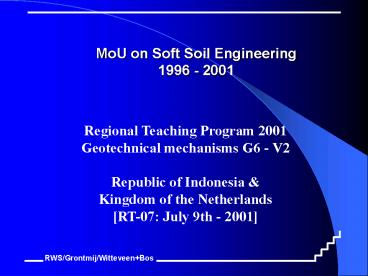Geotechnical Mechanism
1 / 16
Title: Geotechnical Mechanism
1
MoU on Soft Soil Engineering1996 - 2001
Regional Teaching Program 2001 Geotechnical
mechanisms G6 - V2 Republic of Indonesia
Kingdom of the Netherlands RT-07 July 9th -
2001
RWS/Grontmij/WitteveenBos
2
Content
- Introduction
- Settlement
- Strength, Shearing and Stability
- Horizontal Displacement
- Negative Skin Friction
- Squeezing
- Uplift
- Earth Structure and Geotechnical Mechanism
- Other Mechanism
3
Introduction
- Some major geotechnical mechanism are
- Settlement
- Shearing stability
- Squeezing
- Uplift
- Horizontal deformation
- Negatives skin friction
4
Settlement
- Load-Stress-Pore Water Pressure-Dissipation of
PWP is known as consolidation - Consolidation depend on
- Soil properties
- Geometry of soil layer
- Water pressure, and
- Boundary condition
- Factor of peat significantly behavior
- The fibre structure is very open, a low content
of fixed material - The fine material largely consist of organic
material - The organic material are found in the form of
residual fibre - Peat cannot be described by traditional methods
of settlement calculation (Fokkens/den Haan,
Edil, Noor Endah)
5
Strength, Shearing and Stability (1)
- Peat soil strength characteristic
- Peat parameter to classification
- The percentage and nature of inorganic component
- The composition of fibre and wood
- The present of big fibre and wood
- The weathering degree of fibre
- Spatial orientation of fibre
- The effect of fibre on the shear strength
- Effect of load and fibre direction
- The main direction is usually horizontal
6
Triaxial Compression Vs Simple Shear (Anisotrop)
7
Strength, Shearing and Stability (2)
- Undrained shear strength
- Characteristic of shear strength not only a
function of the material itself, but also of the
stress applied, and the manner in which the
stress applied - Influence of the excess ??, its pore water
pressure increase by ?? - Shearing and stability
- Shearing resistance in the soil is insufficient
to prevent the continuous movement of particular
sections of ground along a sliding surface. The
mechanism is called shearing - The stability of construction is often ensured by
control of stresses in the soil, to prevent
occurrence of failure. Failure is the last phase
of deformation behavior, where the stresses have
reached a level at which deformation increase
continuously
8
Shear Strength as a function of Effective Stress
9
Drained Shear Strength
- ? c' ?vk' x tan (?')
10
Horizontal Displacement
- Finite element program
- Mohr-Coulomb model
- Cam-Clay model
- Parameter for finite element can be determined in
several ways, such as by - Inclinometer tube
- Pressure meter test
- Laboratory test
- Correlation with unit weight, CPTs or Oedometer
test
11
Widening of the Dike induce Lateral Force on
Piles (Figure 3)
12
Negative Skin Friction
- The skin friction of filling materials is usually
greater than that of the highly compressible
layers - The greater of the thickness of fill, the greater
of the total vertical force on the foundation
elements. This force is called negative skin
friction. - The mechanism can considerably reduce the
allowable bearing capacity of a foundation - Moreover, negative skin friction can also
increase the normal stress in foundation piles
13
Squeezing
- Low bearing capacity layer is situated above firm
layer - The weak layer is subjected to a vertical load,
e.g. a fill with limited horizontal - The intermediate soft layer is forced
horizontally outwards while the underlying layer
is only slightly deformed. The fill merely
undergoes settlement. This phenomenon is known as
squeezing.
14
Uplift
- When an impermeable peat layer of low bearing
capacity overlies a sand layer with relatively
high water pressure, an unstable situation can
occur in the peat layer due to the upwards water
pressure. - An phenomenon of this kind can particular be
observed in excavations
15
Earth Structure and Geotechnical Mechanism
(Figure 4)
16
Other Mechanism
- It certain circumstances, other mechanisms may
also play a part. These include phenomena such as
micro-instability, swelling, piping and erosion - Another mechanism is the effect of plants and
animals on the stability of the structure, such
as the influence of plant and tree roots or the
possible consequences of holes dug by burrowing
animals.































